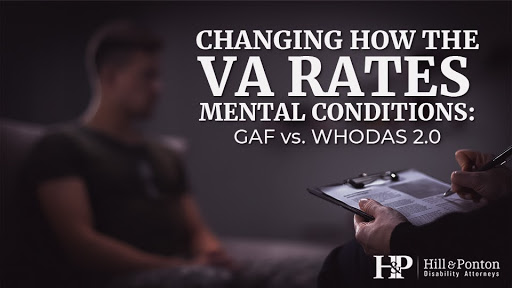Changing How the VA Rates Mental Conditions: GAF Scores vs. WHODAS 2.0
Veterans can experience a variety of mental health issues following military service. From mild anxiety to occasional panic attacks to PTSD, there are many mental illnesses that can affect a veteran’s daily life. In order to award disability benefits for mental health conditions, the VA uses a scoring system to rate the symptom severity.
While they once used GAF scores (the Global Assessment of Functioning) as their main rating system, they now use a system called WHODAS 2.0. This is because WHODAS 2.0 is the new standard of the American Psychiatric Association Diagnostic and Statistical Manual of Mental Disorders guide.
This guide will outline the main differences between these two systems and why the VA made the switch.
What is a GAF Score?
GAF stands for the Global Assessment of Functioning Scale. A clinician can use this to measure a veteran’s overall level of functioning and their ability to carry out activities of daily living. For veterans who are claiming PTSD or any mental health condition, they should know that their GAF score can play an important role in how the VA decides their claim. Before proceeding, you should know that the VA has now been using the Diagnostic and Statistical Manual of Mental Disorders, fifth edition (DSM-V or DSM-5). The DSM-V no longer uses GAF scores, but instead now uses the assessment tool known as the WHODAS 2.0.
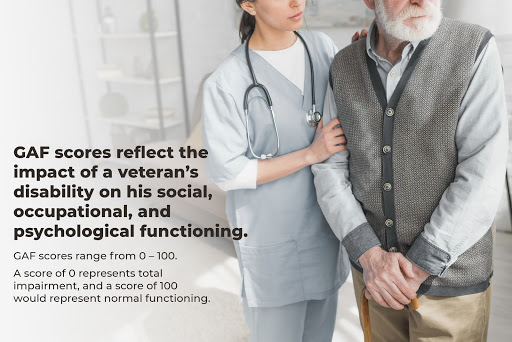
The Global Assessment of Function scale is a 100-point score that measures a veteran’s overall level of psychological, social and occupational functioning on a hypothetical continuum, with 100 measuring minimal limits of daily functioning and the measurement of 0 indicating that the veteran or individual is having severe difficulty with daily activities and functions.
Typical GAF Score Psychology: Ranges In The Rating Scale
- 100-91: Superior functioning in a wide range of activities – no symptoms
- 90-81: Absent or minimal symptoms, good functioning in all areas, interested and involved in a wide range of activities. Socially effective and generally satisfied with life
- 80-71: Transient symptoms and expectable reactions to psychosocial stressors; no more than slight impairment in social, occupational or school functioning
- 70-61: Some mild symptoms or some difficulty in social, occupational, or school functioning, but generally functioning pretty well; has some meaningful interpersonal relationships
- 60-51: Moderate symptoms or moderate difficulty in social, occupational, or school functioning (i.e., few friends, conflicts with peers or coworkers)
- 50-41: Serious symptoms or serious impairment in social, occupational, or school functioning
- 40-31: Some impairment in reality testing or communication or major impairment in several areas, such as work or school, family relations, judgment, thinking, or mood
- 30-21: Behavior is considerably influenced by delusions or hallucinations or serious impairment in communication or judgment, or inability to function in almost all areas
- 20-11: Some danger of hurting self or others or occasionally fails to maintain minimal personal hygiene; or gross impairment in communication
- 10-1: Persistent danger of severely hurting self or others or persistent inability to maintain minimal personal hygiene or serious suicidal act with clear expectation of death
Based on these GAF ratings, the VA would decide the severity of the veteran’s condition to determine the amount of disability benefits they would receive. However, the WHODAS 2.0 system has since become the standard for mental health evaluations.
Global Assessment of Functioning: What is a WHODAS 2.0?
As mentioned above, the DSM replaced GAF scores with the WHODAS 2.0 tool. WHODAS is based on the model of diseases where the assessment of impairment and disability is separate from the diagnosis of the disease. The actual test for WHODAS 2.0 is a self-report of assessment by the patient which evaluates six domains and the patient’s ability to perform in each of those domains over the last 30 days:
- Understanding and Communicating
- Getting Around (mobility)
- Self-care
- Getting along with people (social functioning and interpersonal functioning)
- Life activities (home, academic, and occupational functioning)
- Participation in society (participation in family, social, and community activities).
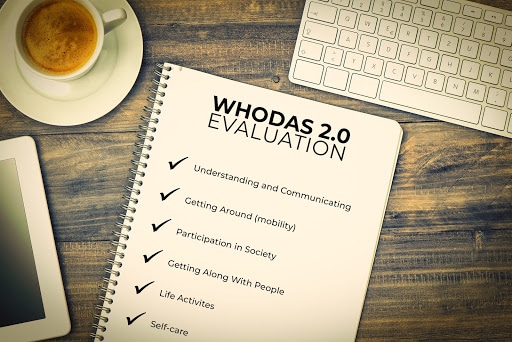
The WHODAS 2.0 comes in two versions a 36- and a 12- question format. Each format is available in three versions: a self-administered, proxy-administered, and a rater-administered. (Proxy versions are meant for a third party, such as a caregiver or family member to take if the veteran is unable to complete the test himself.)
After completing the test, there are two scoring methods available: a simple scoring method and a complex scoring method. The simple scoring is done by hand and gives no weight to individual items, nor does it convert to a standardized scale. The complex method requires a computer to score and is based on an item-response theory. For rating purposes, this will likely be the version implemented by the VA to standardize scores.
Why Has VA Replaced GAF For WHODAS?
The WHODAS test is more reliable and responsive to change across different communities and geographic regions than GAF. It’s considered a more reliable global assessment scale. WHODAS has demonstrated good facial reliability across countries, populations, and diagnostic groups including both ages and genders. For these reasons, the DSM-V has decided to remove GAF from its diagnostic toolbox and add the WHODAS 2.0.
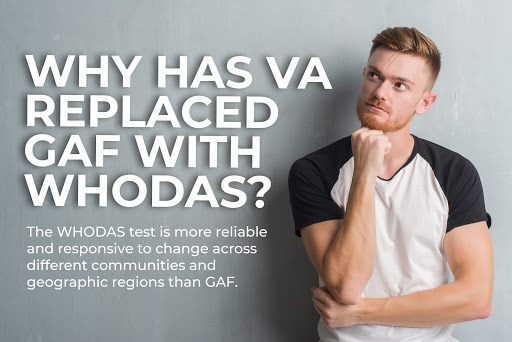
For VA PTSD ratings, the GAF score is not now meaningless for VA ratings. In fact, many VA PTSD decisions still consider GAF scores, but there is a change coming. The change should mean more reliable and consistent ratings for veterans seeking help for their mental disorders. The change also means that there are going to be errors as raters adjust to the new criteria. As a result, make sure examiners are recording your PTSD symptoms and not just checking boxes on a sheet. Inadequate information could mean an inaccurate assessment.
How Does The VA Rate Mental Health Claims?
The VA recognizes and grants service connection for a number of mental health disorders. Some of the most common ratings are post-traumatic stress disorder (PTSD), major depressive disorder (MDD), general anxiety disorder, and bipolar. Each of these mental health disorders are described by the Diagnostic and Statistical Manual of Mental Disorders, 5th Edition, more commonly referred to as the DSM-V. Let’s look at how PTSD is rated with the DSM.
How Does VA rate PTSD?
Prior to the DSM-V, the VA used the DSM-IV-TR for rating mental disorders. The DSM-IV uses the global assessment of functioning (or GAF) score to rate the severity of a mental disability that a veteran suffers. GAF scores reflect the impact of a veteran’s disability on his social, occupational, and psychological functioning. GAF scores range from 0 – 100. A score of 0 represents total impairment, and a score of 100 would represent normal functioning. A GAF score below 50 represents serious to severe social impairment. The VA has used GAF scores in its determination of the impact that mental illness has on the affected individual.
Does VA Still Use The GAF Scale to Rate PTSD?
Critics complained that GAF scores were too subjective to be reliable in reporting the disorder’s actual impairment. Generally, a rater’s training and performance are essential to a GAF score’s reliability. GAF scores often correlate more with the severity of the symptoms that an individual is experiencing.
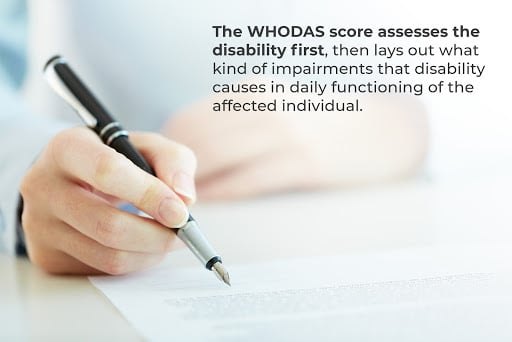
The scores do not usually reflect the functional impact those symptoms have on an individual in day to day situations. For these reasons and others, the authors of the DSM-V decided to exclude GAF scores in rating PTSD and other mental disorders. In the place of GAF, the DSM-V uses the World Health Organization Disability Assessment Schedule 2.0 (WHODAS 2.0).
How Does The VA Use WHODAS 2.0?
The DSM-V writers recommend using WHODAS 2.0 to assess PTSD for clinical uses. The first difference between GAF and WHODAS is how it rates mental disorders and the resulting disability. Rather than assigning one numerical score, WHODAS separates the medical and psychiatric disorders from the disabilities that those disorders cause. In effect, the WHODAS score assesses the disability first. Then lays out what kind of impairments that disability causes in the daily functioning of the affected individual.
How does WHODAS 2.0 Affect My VA PTSD Rating?
So, what does the WHODAS look like? In WHODAS classifications, PTSD results in particular impairments to functioning. The PTSD classification covers activity limitations, participation restrictions, and the impact on a person’s interaction with his environment. Unlike the GAF scale, the new test takes into account the personal factors of a person rather than trying to fit everyone into broad categories.
The WHODAS uses the International Classification of Functioning to assess social factors related to the individual’s functioning. This includes personal circumstances (age, education, and motivation) as well as the individual’s environment. The individual’s environment is not limited to just the physical aspects, but also takes note of accommodations and support available.
WHODAS, unlike GAF, recognizes two individuals can have PTSD and its functional impairments. But those individuals could have different degrees of disability due to personal and environmental factors. For example, one individual might experience a mildly depressed mood or mild insomnia, while another might report suicidal ideation. The new rating scale would assess these veterans as individuals, taking all factors into account. This differs from GAF score psychology.
If your PTSD disability claim has been denied, the team at Hill & Ponton is here to help. Our team of experienced attorneys have decades of experience in social security and veterans disability law, so former service members can obtain the benefits they deserve.
